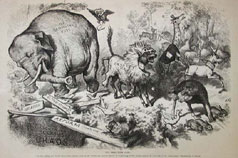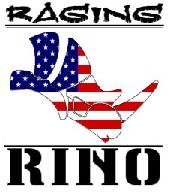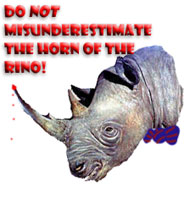November 07, 2005
Birth Of A Symbol

Today is the anniversary of the publication of Thomas Nast's 1874 Harper's Weekly cartoon depicting the Republican Party as an elephant. The rest, as they say, is history. My very favorite example of this symbol was the cover of National Review just after the 1994 elections done by the late, great, Jeff McNally. (Unfortunately, I can't find it on-line.) It featured a herd of GOP elephants, with Newt Gingrich as a barbarian astride the lead beast, crashing through the gates of a Roman-style Dee Cee, while Bill Clinton fiddled in the White House and Hillary ran herself through with a caduseus.
I find this fascinating for several reasons, none of them really having to do with party affiliation. The first is that I myself drew political cartoons for student newspapers both as an undergrad and in law school, and appreciate the effectiveness of this kind of symbolism, especially where, as is often the case with editorial work, the cartoonist has only one or two panels to make his point.
The other main reason it interests me is because, at least according to Robert Graves, the modern political cartoon is the closest current example we have to ancient Greek pictography. Graves held the theory that the Greeks of the Homeric Era - say, from around 1500 B.C. to 1200 B.C., were considerably more sophisticated than their Classical Era (500-400 B.C.) descendents gave them credit for being. Many of the standard myths we have - the Minotaur, Centaurs, the flight of Icarus and so on, were Classical in origin and were based on their viewing of pictographs - bull-headed men and the like - left by their earlier ancestors. Greek culture went through a serious decline between these two periods, and the original meanings of these pictographs were lost. The Classical Greeks could not imagine that their ancestors were at all sophisticated, so took the pictographs literally, inventing stories that they didn't believe themselves, but reckoning that their forebearers did.
Graves was of the opinion that the pictographs were, in fact, symbolic, and developed a theory that they were actually totemic in nature, various half-man, half-beast pictures representing tribal fraternities and sororities, with the given animal as their guiding spirit. He centered a very entertaining version of the story of Jason and the Argonauts around this idea in the novel Hercules, My Shipmate.
I bring this up not so much to argue whether Graves was right or wrong, but simply to point out that as effective as this kind of symbolism is, once the key is lost, it becomes useless. We look at editorial cartoons of the GOP Elephant and the Democratic Donkey with an instant understanding of the shorthand involved. If we didn't know what these symbols meant, we couldn't possibly understand the point of the cartoon and might quite possibly, like the Classical Greeks, start inventing stories of our own to explain them.
Posted by Robert at November 7, 2005 01:06 PM | TrackBackThe repiblican elephant and demacratic donkey and notice the donkey in the lion skin nothings changed the demcrats are still pulling off false scares
Posted by: BIRDZILLA at November 7, 2005 03:36 PM





